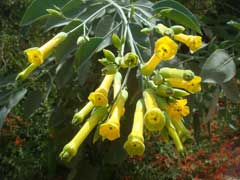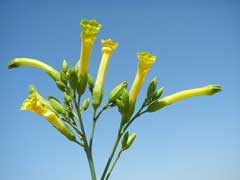 |
|
http://commons.wikimedia.org/wiki/User:Miwasatoshi |
 |
| www.flickr.com/photos/valter/ |
Translate this page:
Summary
Physical Characteristics

 Nicotiana glauca is an evergreen Shrub growing to 3 m (9ft) by 3 m (9ft).
Nicotiana glauca is an evergreen Shrub growing to 3 m (9ft) by 3 m (9ft).
See above for USDA hardiness. It is hardy to UK zone 8 and is frost tender. It is in leaf all year, in flower from August to October, and the seeds ripen from September to October. The species is hermaphrodite (has both male and female organs) and is pollinated by Lepidoptera (Moths & Butterflies).
Suitable for: light (sandy), medium (loamy) and heavy (clay) soils and prefers well-drained soil. Suitable pH: mildly acid, neutral and basic (mildly alkaline) soils. It cannot grow in the shade. It prefers moist soil.
UK Hardiness Map
US Hardiness Map
Synonyms
Plant Habitats
Cultivated Beds;
Edible Uses
The leaves have been made into a drink[257]. Some care should be exercised here. The tea will contain nicotine, and this can be toxic to the body. There is some evidence that Nicotiana glauca may have led to accidental poisoning when it was mistaken for other plants. We would recommend that ingestion is not considered. Please see the warning in Known Hazards.
References More on Edible Uses
Medicinal Uses
Plants For A Future can not take any responsibility for any adverse effects from the use of plants. Always seek advice from a professional before using a plant medicinally.
Antirheumatic Poultice Skin
A poultice of the leaves can be applied to cuts, bruises, swellings and other wounds[257]. The plant has been used as a poultice for removing the pus from scrofulous sores or boils[257]. A poultice of the leaves has been applied to inflamed throat glands[257]. An infusion of the leaves has been used as a steam bath in the treatment of rheumatism[257].
References More on Medicinal Uses
The Bookshop: Edible Plant Books
Our Latest books on Perennial Plants For Food Forests and Permaculture Gardens in paperback or digital formats.

Edible Tropical Plants
Food Forest Plants for Hotter Conditions: 250+ Plants For Tropical Food Forests & Permaculture Gardens.
More

Edible Temperate Plants
Plants for Your Food Forest: 500 Plants for Temperate Food Forests & Permaculture Gardens.
More

More Books
PFAF have eight books available in paperback and digital formats. Browse the shop for more information.
Shop Now
Other Uses
References More on Other Uses
Cultivation details
Industrial Crop: Pesticide Regional Crop
Prefers a well-drained deep rich moist soil in a sunny position[1, 200]. This species is hardy to about -5°c[200]. Plants can survive the winter outdoors in the milder parts of Britain, though they usually act as herbaceous perennials in such conditions[200]. Plants require more than 14 hours daylight per day in order to induce flowering[169].
Carbon Farming
-
Industrial Crop: Pesticide
Many plants provide natural pesticides.
-
Regional Crop
These crops have been domesticated and cultivated regionally but have not been adopted elsewhere and are typically not traded globally, Examples in this broad category include perennial cottons and many nuts and staple fruits.
References Carbon Farming Information and Carbon Sequestration Information
Temperature Converter
Type a value in the Celsius field to convert the value to Fahrenheit:
Fahrenheit:
The PFAF Bookshop
Plants For A Future have a number of books available in paperback and digital form. Book titles include Edible Plants, Edible Perennials, Edible Trees,Edible Shrubs, Woodland Gardening, and Temperate Food Forest Plants. Our new book is Food Forest Plants For Hotter Conditions (Tropical and Sub-Tropical).
Shop Now
Plant Propagation
Seed - surface sow in a warm greenhouse about 10 weeks before the last expected spring frosts. The seed usually germinates in 10 - 20 days at 20°c. Keep the soil moist and pot up as soon as the plants are big enough to handle, planting them out after the last expected frosts.
Other Names
If available other names are mentioned here
Native Range
SOUTHERN AMERICA: Bolivia, Argentina (Córdoba, Mendoza, Buenos Aires, Catamarca, Corrientes, Entre Ríos, Formosa, Jujuy, La Rioja, Salta, San Luis, Santa Fe, Santiago del Estero, Tucumán, Ciudad Autónoma de Buenos Aires)
Weed Potential
Right plant wrong place. We are currently updating this section.
Please note that a plant may be invasive in one area but may not in your area so it's worth checking.
Conservation Status
IUCN Red List of Threatened Plants Status :

Growth: S = slow M = medium F = fast. Soil: L = light (sandy) M = medium H = heavy (clay). pH: A = acid N = neutral B = basic (alkaline). Shade: F = full shade S = semi-shade N = no shade. Moisture: D = dry M = Moist We = wet Wa = water.
Now available:
Food Forest Plants for Mediterranean Conditions
350+ Perennial Plants For Mediterranean and Drier Food Forests and Permaculture Gardens.
[Paperback and eBook]
This is the third in Plants For A Future's series of plant guides for food forests tailored to
specific climate zones. Following volumes on temperate and tropical ecosystems, this book focuses
on species suited to Mediterranean conditions—regions with hot, dry summers and cool, wet winters,
often facing the added challenge of climate change.
Read More
Expert comment
Author
Graham.
Botanical References
200
Links / References
For a list of references used on this page please go here
Readers comment